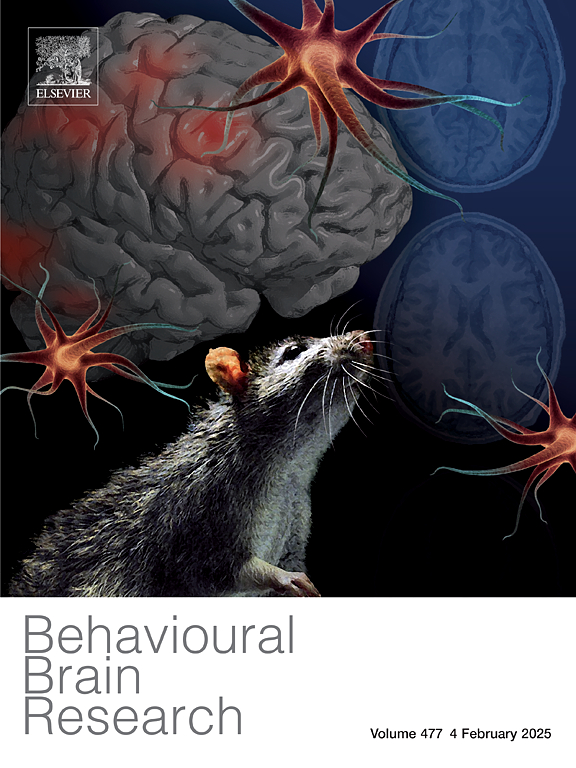数字比较中执行功能脑区活动的个体差异。
IF 2.3
3区 心理学
Q2 BEHAVIORAL SCIENCES
引用次数: 0
摘要
数学技能需要数学特定技能和领域通用技能的集成,例如执行功能(EF)。神经影像学研究一致报告了算术任务时顶叶内沟的激活;然而,与EF相关的额叶脑区域的激活在不同的研究中有所不同。在数学任务中,与EF相关的大脑区域的差异可能部分归因于个体和任务需求的差异。本研究考察了青少年典型数学和EF区域中与比例效应相关的神经激活,并随后考察了该活动与数学能力和EF的同时获得性行为测量的关系。研究结果揭示了符号(如数字)和非符号(如点阵)刺激的行为测量和神经比例效应之间的差异关系。左侧下顶叶(IPL)和左侧下额叶交界处(IFJ)的符号数比较中的神经比例效应与个体的计算分数呈正相关。同样,左右下顶叶非符号比较时的神经比例效应与个体的数学流利度呈正相关。然而,尽管个体抑制控制的测量与左侧IFJ的非符号神经比例效应正相关,但工作记忆与左侧IPL、左侧IFJ、左侧中央前回和左侧后背外侧前额叶皮层的符号神经比例效应正相关。这些发现表明,数字信息的格式会影响神经系统的参与,而参与程度因数学能力的个体差异而异。本文章由计算机程序翻译,如有差异,请以英文原文为准。
Individual differences in the activity of executive function brain regions during number comparison
Math skills require the integration of math-specific and domain-general skills, such as executive functions (EF). Neuroimaging studies consistently report intraparietal sulci activation during arithmetic tasks; however, activation of frontal brain regions associated with EF varies across studies. The discrepancies in brain regions associated with EF during math tasks may be due, in part, to variations amongst individuals and task demands. The current study examined neural activations associated with ratio effect in canonical math and EF regions in adolescents and subsequently examined how this activity was related to concurrently acquired behavioral measures of math ability and EF. Findings revealed differential relations between behavioral measures and neural ratio effects for symbolic (i.e., digits) vs. nonsymbolic (i.e., dot arrays) stimuli. The neural ratio effect during symbolic number comparison in the left inferior parietal lobe (IPL) and left inferior frontal junction (IFJ) correlated positively with an individual’s calculation scores. Similarly, the neural ratio effect during nonsymbolic comparison in the right and left inferior parietal lobes correlated positively with an individual’s math fluency. However, while a measure of an individual’s inhibitory control positively correlated with the nonsymbolic neural ratio effect in the left IFJ, working memory positively correlated with the symbolic neural ratio effect in the left IPL, left IFJ, left precentral gyrus, and left posterior dorsolateral prefrontal cortex. These findings suggest that the format of numerical information influences the neural systems engaged and that engagement varies with individual differences in math abilities.
求助全文
通过发布文献求助,成功后即可免费获取论文全文。
去求助
来源期刊

Behavioural Brain Research
医学-行为科学
CiteScore
5.60
自引率
0.00%
发文量
383
审稿时长
61 days
期刊介绍:
Behavioural Brain Research is an international, interdisciplinary journal dedicated to the publication of articles in the field of behavioural neuroscience, broadly defined. Contributions from the entire range of disciplines that comprise the neurosciences, behavioural sciences or cognitive sciences are appropriate, as long as the goal is to delineate the neural mechanisms underlying behaviour. Thus, studies may range from neurophysiological, neuroanatomical, neurochemical or neuropharmacological analysis of brain-behaviour relations, including the use of molecular genetic or behavioural genetic approaches, to studies that involve the use of brain imaging techniques, to neuroethological studies. Reports of original research, of major methodological advances, or of novel conceptual approaches are all encouraged. The journal will also consider critical reviews on selected topics.
 求助内容:
求助内容: 应助结果提醒方式:
应助结果提醒方式:


